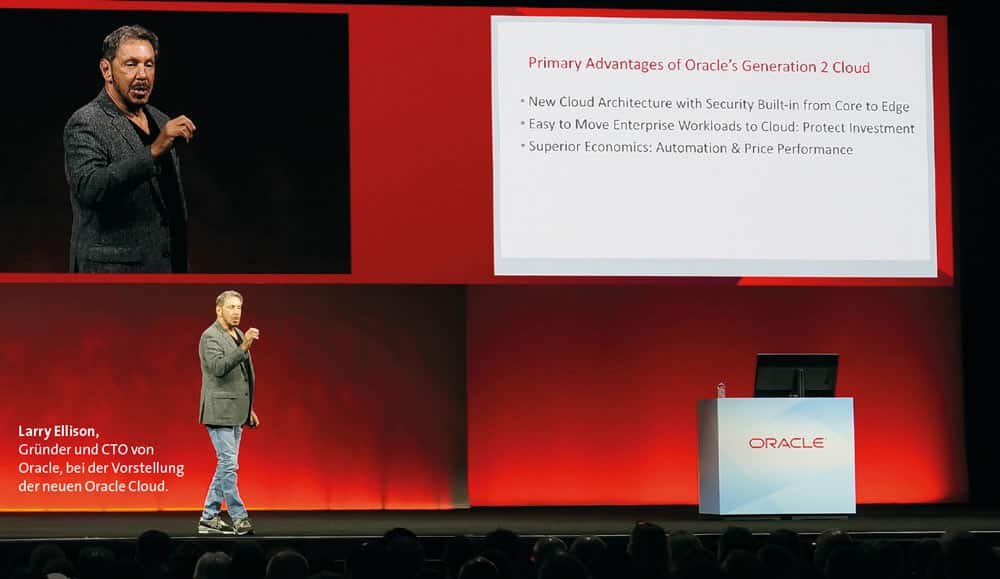SAP in the New Oracle Cloud


Because of a modified architecture, the next-generation cloud is designed for the use of cloud services in mission-critical enterprise environments. The new generation of the Oracle Cloud offers enterprise cloud services for mission-critical environments.
The primary requirements for a highly optimized cloud use of customers are threefold: security, costs, and performance. That’s why Oracle has decided to give its cloud a new architecture which has significantly more enterprise benefits compared to its predecessor.
This is true for non-SAP customers as well as for SAP users. In October of 2017, SAP announced that the Oracle Cloud and the Oracle Cloud Infrastructure (OCI) are certified. One focal point is the OCI certification for main Netweaver component SAP Application Server Abap/Java. Consequently, SAP customers are able to use their Business Suite applications with ERP as well as Netweaver-based BI, CRM, or SCM applications in combination with Oracle databases or with the Oracle Exadata Data Machine in the Cloud Infrastructure as Infrastructure as a Service (IaaS).

The Oracle Cloud Infrastructure is one part of the company’s broad cloud solutions portfolio which also includes PaaS (Platform as a Service) and SaaS (Software as a Service). OCI offers numerous and diverse core infrastructure resources on a subscription basis, following the IaaS principle. These resources include flexible compute and storage services so that companies can profitably leverage mission-critical workloads in the form of cloud services. Database services can be used with the Oracle database or Exadata cloud services.
Security first
The primary focus of the Oracle Cloud’s redesign is the topic of security. Generally speaking, a lot of cloud providers did not design their cloud environments for mission-critical enterprise use – and it shows. Even today, user code and cloud control code is often stored and operated on the same cloud shared computers (with Intel CPU, shared CPU, memory, storage, and shared network ports).
This means that cloud providers are able to look at and access customer data. This can lead to a variety of issues, as it can be easily misused. What is more, a cloud shared computer opens up the possibility of leveraging user code to access cloud control codes, which is yet another security risk.
The new Oracle Cloud avoids these issues by offering separate Bare Metal shapes (and VMs if needed) and separate cloud control panels. There is no user code stored on cloud control panels. This means that the Oracle Cloud combines one or even more implemented networks which strictly separate the processing of customer and cloud control code. Furthermore, there are no connections between individual customer zones whatsoever.
The advantages of this concept are twofold. On the one hand, Oracle cannot look at or access customer code. On the other hand, customers or customer users cannot access cloud control code and are consequently not able to initiate a threat or a cyberattack. In this regard, Oracle has created insurmountable barriers with its new cloud to protect cloud services and cloud control mechanisms through independent and separate zones. In the cloud provider scene, this is an unique selling point for Oracle.
Concerning security, there is one more thing worth mentioning. All available methods and technologies for warding off possible threats in a core-to-edge security strategy are taken into consideration in the new cloud. For example, AI and machine learning, which make it possible to scour the cloud for threats, recognize them, and eliminate them, all automatically.
Also new: Key Management Service (KMS). It provides customers with a sophisticated data encryption management, an integrated Cloud Access Security Broker (CASB) which suggest secure configuration and includes monitoring, a Web Application Firewall (WAF) to protect the system from web attacks, as well as an efficient DDoS protection to tackle possible threats stemming from faulty or manipulated customer applications.

Cost and performance benefits
Besides security, enterprise customers also think that price and performance of their cloud services are important and often base the decision of which cloud provider to use on these two indicators. For that reason, Oracle considered them carefully while redesigning its cloud.
According to company-own analysis and statistics as well as studies from external corporations (such as AVM Consulting), the Oracle Cloud offers more benefits when compared to, for example, Amazon Web Services (AWS). During the presentation of the heavily redesigned Oracle Cloud (October 2018 at Oracle Open World), it was shown that per month, AWS had to use three times higher Basic Compute Services, that its Block Storage Services cost 30 times, its Network Services (example used: 100 TB) even taking 100 times as much as when using the new Oracle Cloud.
The same is true for compute performance: that of the Oracle Cloud Infrastructure are 45 percent higher than AWS’s. Additionally, Oracle’s memory processing is up to 14 percent, the block storage use more than 500 percent, and the network processing has 100 percent higher performance than that of Amazon.
Furthermore, the new Oracle Cloud offers other company goals and benefits. For example, there are now new mechanisms in place for an even easier “lift and shift” to the cloud, resulting in fast implementation of more cloud benefits.
Oracle has a principle: the same functionality and performance should be available on-premise as well as in the cloud – and whenever it is possible, there should be higher functionality and performance in the cloud – always following the guideline of protecting IT investments. What is more, the Oracle Cloud and the included Oracle Cloud infrastructure help expanding the cloud regions with deep edge services capacities around the globe.
Autonomous Database
The cloud relaunch prepares for the Oracle Autonomous Database which comes with integrated machine learning functionalities. It operates as a high-performance and high-availability Oracle Autonomous Database cloud service in the Oracle Cloud Infrastructure. It maintains and scales (from top to bottom) itself. If worst comes to worst, it can even repair itself or establish a higher level of security without human interference.
Furthermore, users profit from automated key management processes, like backup and recovery, patching, tuning, or upgrading, so that critical infrastructures can be operated without downtimes in the cloud age.
These infrastructures include analytics (ADW, Autonomous Database Warehouse), transaction processing (ATP, Autonomous Transaction Processing) and Exadata environments (Exadata Cloud Infrastructure).
Beta test customers (with non-SAP systems) report high cost savings related to the use of Oracle Autonomous Database. A German user company, for example, stated that it saved up to 20 percent on maintenance costs. Oracle and SAP are currently assessing the situation of their joint Netweaver customers to determine when and which Oracle Autonomous Database cloud features should be made available to them.






